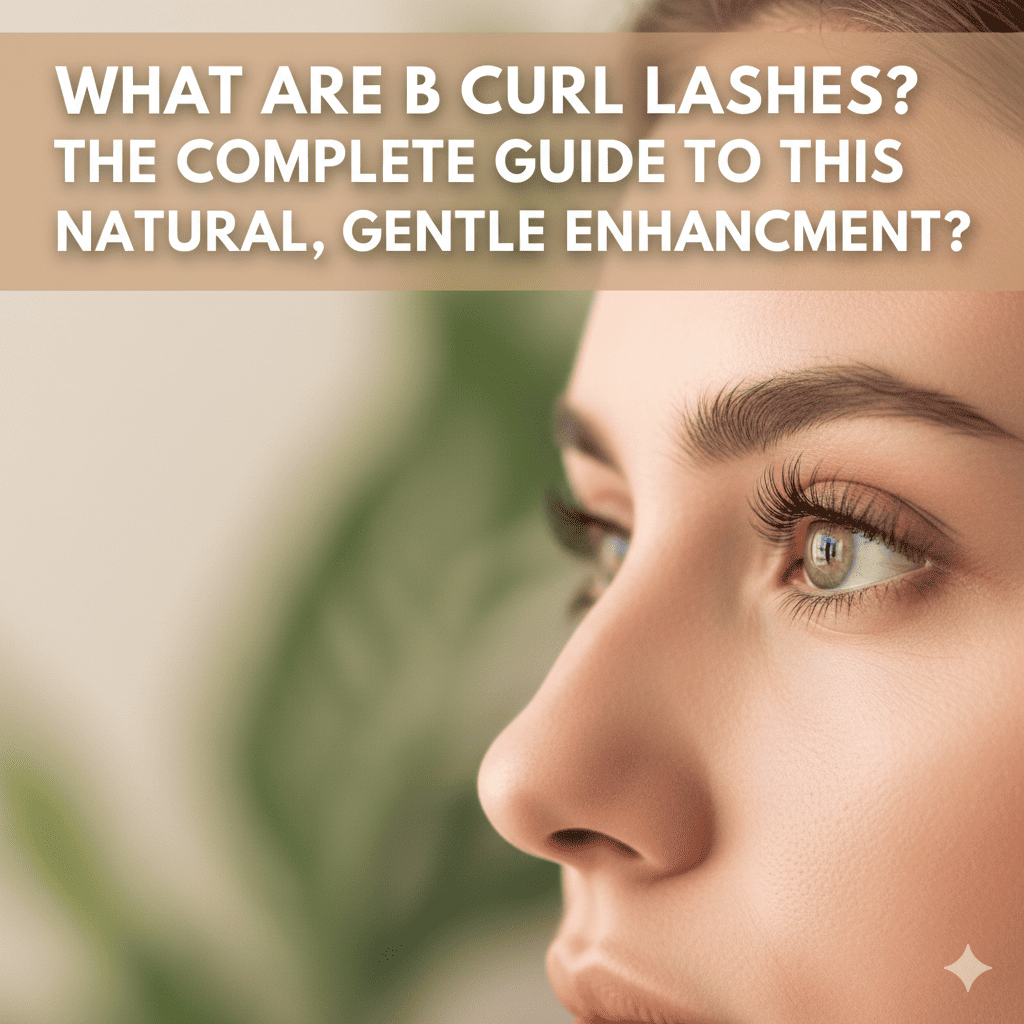Feeling overwhelmed by the choices in lash adhesives? You’re not alone. Choosing between Korean lash glue and Chinese lash glue manufacturers can be a real challenge for lash artists and lash businesses. 1
The truth is, both Korean and Chinese lash glue can offer excellent quality. The key difference often lies in speed and customization options, with Chinese glues often being faster and offering lower MOQs, making them beginner-friendly.

Let’s dive into a detailed comparison to help you make the best choice for your lash extension application, exploring lash glue ingredients, and comparing lash glue drying times. We’ll also touch upon key factors like ISO certification, ingredient sourcing, and how to find reliable suppliers through trade shows, distributors, and training courses.
Who Manufactures Korean Lash Glue?
Struggling to find specific details on Korean lash glue manufacturers? It’s a common issue, as many brands keep their manufacturing sources confidential.
While specific manufacturer names are often undisclosed, "Made in Korea" generally indicates a high standard of quality and adherence to strict regulations, particularly in ingredient control, impacting the final product’s impact.

Dive Deeper: Understanding the Korean Lash Glue Landscape
Although it’s hard to pinpoint individual manufacturers, it is well-known that the Korean beauty industry, in general, is heavily regulated. This impacts everything from skincare to cosmetics, including lash adhesives. These regulations often translate to:
- Ingredient Transparency: Stricter rules regarding ingredient listing and safety.
- Quality Control: More rigorous quality checks throughout the production process.
- Research and Development: A strong focus on innovation and new product development.
| Feature | Description |
|---|---|
| Regulation | Strict oversight by Korean authorities, ensuring high safety and quality standards. |
| Ingredient Focus | Emphasis on safe, high-quality ingredients, with detailed labeling and transparency. |
| Innovation | Continuous research and development, leading to advanced formulations and application techniques. |
| General Reputation | "Made in Korea" often signifies a product that meets high expectations for safety, efficacy, and quality, due to the country’s stringent cosmetic regulations and advanced beauty industry. |
Which Chinese Manufacturers are Leading in Eyelash Glue Quality?
Confused about which Chinese manufacturers to trust for quality lash extension glue? It’s understandable; the market is vast.
While I can’t endorse specific brands beyond UBLash, it’s important to know that many Chinese manufacturers have significantly improved their quality, look for ISO certification and check the ingredient sourcing, and are now competing with Korean brands.
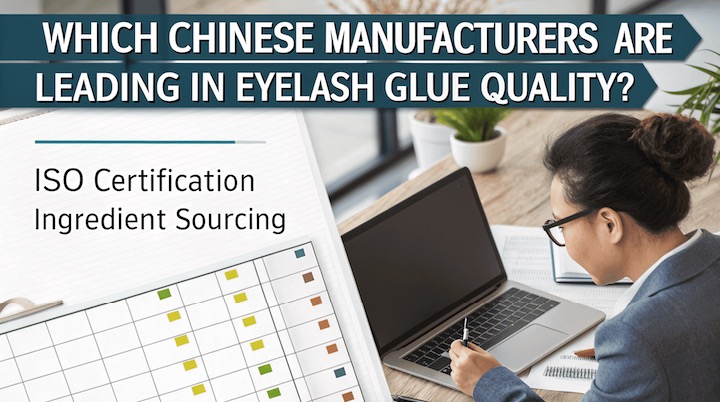
Dive Deeper: Identifying Quality Chinese Manufacturers
Here’s what to look for, when you want to find out which chinese manufacturers are leading in eyelash glue quality:
- Certifications: Look for manufacturers that comply with international standards like ISO certification.
- Ingredient Sourcing: Inquire about the origin of their raw materials.
- Client Testimonials: Seek reviews and feedback from other lash technicians.
- Transparency: A reputable manufacturer will be open about their processes and quality control measures.
- Customization: The ability to offer custom formulations, packaging, and low MOQs, like UBLash, can be a strong indicator of a manufacturer’s capabilities and confidence in their product.
| Criteria | Description |
|---|---|
| Certifications | Indicates compliance with international quality and safety standards. |
| Ingredient Source | Shows commitment to quality and potentially ethical sourcing. |
| Client Reviews | Provides real-world insights into product performance and manufacturer reliability. |
| Transparency | Demonstrates the manufacturer’s confidence in their processes and product quality. |
| Customization | Ability to tailor products and packaging to specific needs, often a sign of a manufacturer’s flexibility and expertise (like UBLash). |
What are the Most Popular Chinese Eyelash Glue Brands Among Professionals?
Wondering which Chinese lash adhesive brands the pros are using? It’s a smart question to ask before investing in the lash industry.
Again, while I can’t name specific brands (besides UBLash), popularity often stems from consistent quality, reliable performance, and good value for money.

Dive Deeper: Finding Popular Brands
Here are some ways to identify popular brands, it’s important for lash artists to keep sourcing:
- Lash Forums and Communities: Check online forums and social media groups dedicated to lash artists.
- Trade Shows: Attend industry trade shows to see which brands are being showcased and used by professionals.
- Distributor Recommendations: Ask reputable lash supply distributors for their top-selling Chinese brands.
- Training Courses: See which brands are used and recommended in professional lash extension training courses.
| Source | How it Helps |
|---|---|
| Online Forums/Groups | Direct feedback and recommendations from fellow lash artists. |
| Trade Shows | Opportunity to see brands in action, talk to representatives, and gather samples. |
| Distributor Recommendations | Insights into best-selling products and brands trusted by professionals. |
| Training Courses | Exposure to brands used and endorsed by experienced lash educators. |
How do the Ingredients in Korean and Chinese Lash Glues Differ?
Concerned about potential differences in lash glue ingredients? It’s a valid concern for client safety.
While specific formulations vary, the core ingredients in both Korean and Chinese lash glues are often quite similar, with the main active component being cyanoacrylate. 1
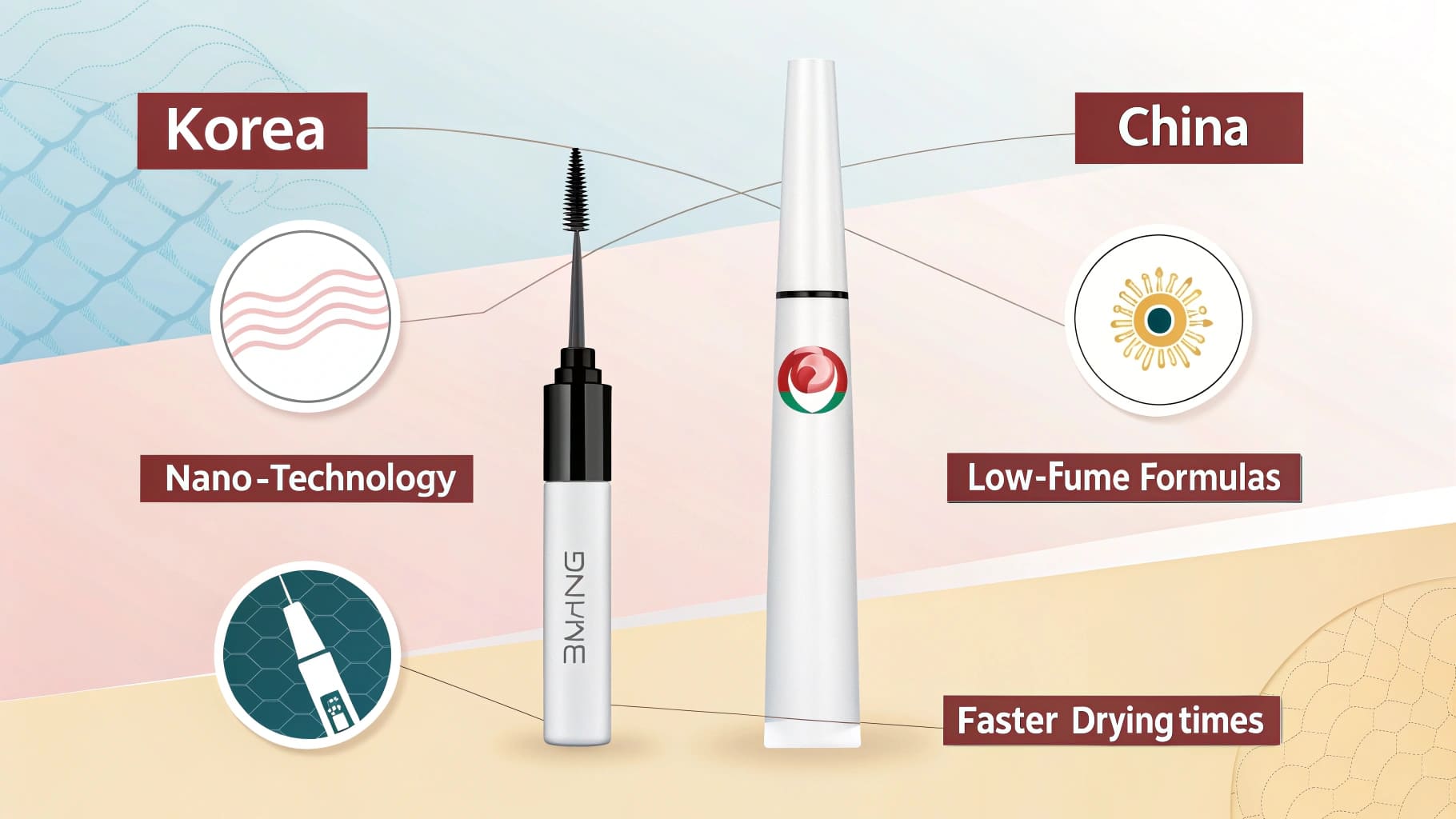
Dive Deeper: Ingredient Similarities and Differences
- Cyanoacrylate: This is the primary adhesive component in most lash glues, regardless of origin. The type and grade of cyanoacrylate can vary (more on this later).
- Stabilizers: These ingredients help to control the curing speed and shelf life of the adhesive. Differences may exist, but the purpose remains the same.
- Thickeners: Used to adjust the viscosity of the glue.
- Pigments: Black pigment is often added to create a seamless blend with the natural lashes.
- Potential Differences: Some Korean glues may prioritize certain "skin-friendly" or hypoallergenic ingredients, but this is not a universal rule. Always check the ingredient list.
| Ingredient | Purpose | Potential Differences |
|---|---|---|
| Cyanoacrylate | The primary adhesive component. | Type and grade may vary (e.g., ethyl cyanoacrylate, methoxy cyanoacrylate, butyl cyanoacrylate). |
| Stabilizers | Control curing speed and shelf life. | Specific chemical compounds may differ, but the overall function is the same. |
| Thickeners | Adjust viscosity. | Specific types may vary. |
| Pigments | Provide color (usually black). | Quality and concentration of pigment may vary. |
| Other Additives | May include ingredients for flexibility, bonding strength, or to reduce irritation (more common in Korean glues). | Korean glues may emphasize hypoallergenic or "skin-friendly" ingredients, but always check the specific product. |
How do the Stabilizers in Korean Lash Glues Compare to those in Chinese Lash Glues?
Worried about how lash glue stabilizers might affect performance? It’s a technical but important detail.
The function of stabilizers is the same in both Korean and Chinese glues: to control drying time and extend shelf life. However, the specific chemical compounds used may differ.

Dive Deeper: Understanding Stabilizers
Stabilizers are crucial for:
- Preventing Premature Curing: They stop the glue from drying out in the bottle.
- Controlling Drying Speed: They influence how quickly the glue sets during application.
- Extending Shelf Life: They help maintain the glue’s effectiveness over time.
It’s difficult to make a blanket statement about which country uses "better" stabilizers. It depends on the specific formulation of each glue. The best approach is to test different glues and see which one performs best for your application speed and environment.
| Stabilizer Function | Impact on Application |
|---|---|
| Premature Cure Prevention | Keeps the glue usable in the bottle for longer. |
| Drying Speed Control | Affects how much time you have to place the extension before the glue sets. Faster drying = less time to adjust. |
| Shelf Life Extension | Maintains the glue’s effectiveness and prevents it from becoming too thick or stringy over time. |
Do Korean Lash Glues Use Different Types of Cyanoacrylate than Chinese Ones?
Wondering if the core adhesive ingredient differs between countries? This is key to understanding lash adhesive performance.
Both Korean and Chinese lash glues can use various types of cyanoacrylate (e.g., ethyl, methoxy, butyl). It’s not strictly determined by country of origin.
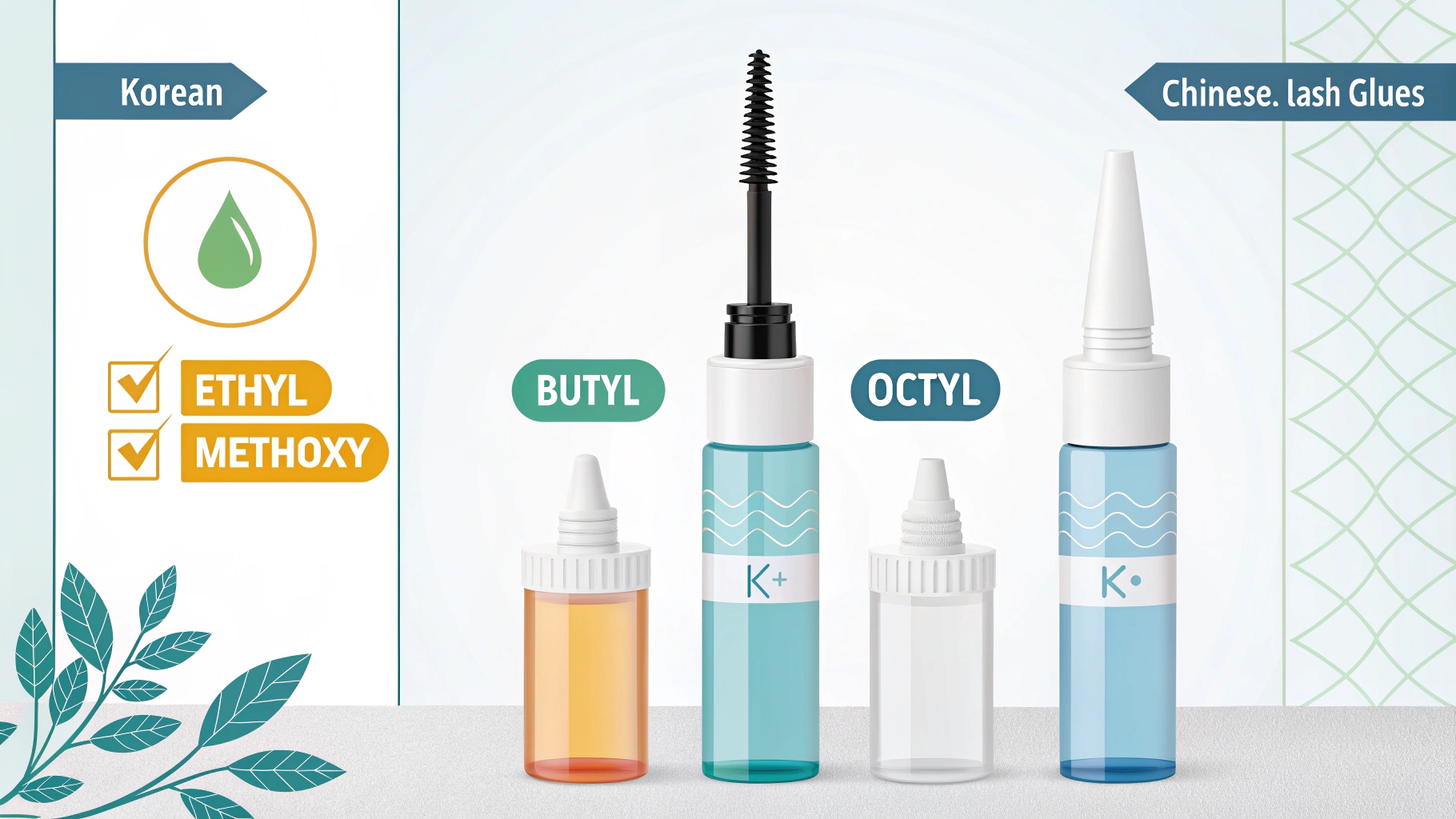
Dive Deeper: Types of Cyanoacrylate
- Ethyl Cyanoacrylate: The most common type, known for strong bond and relatively fast-drying times.
- Methoxy Cyanoacrylate: Often considered less irritating, with a slightly slower drying time.
- Butyl Cyanoacrylate: Slower drying and more flexible glue, sometimes used for sensitive clients.
- Octyl Cyanoacrylate: The slowest drying, most flexible, and least irritating, often used in medical-grade adhesives.
The choice of cyanoacrylate depends on the desired properties of the glue (drying speed, flexibility, fumes). A Korean glue might be more likely to use methoxy or butyl for sensitive clients, but this is a generalization, not a rule. Always check the product information.
| Cyanoacrylate Type | Characteristics |
|---|---|
| Ethyl | Strong bond, fast drying, most common. |
| Methoxy | Potentially less irritating, slightly slower drying. |
| Butyl | Slower drying, more flexible, often used for sensitive clients. |
| Octyl | Slowest drying, most flexible, least irritating, often used in medical applications. |
What are the Most Innovative Features in Current Lash Glues from Korea and China?
Looking for the latest advancements in lash glue technology? Both countries are pushing the boundaries.
Innovation is happening in both Korea and China, focusing on things like faster drying times, lower fumes, improved flexibility, and longer retention.

Dive Deeper: Recent Innovations
- Nano-Technology: Some glues are using nano-particles to improve bonding strength and flexibility.
- Low-Fume Formulations: Efforts to reduce the amount of irritating fumes released during lash extension application1.
- Faster Drying Times: Especially in China, there’s a push for glues that dry in under a second, catering to experienced lash technicians2.
- Improved Retention: Formulations designed to make lash extensions last longer.
- Hybrid Glues: Combining different types of cyanoacrylate to achieve a balance of properties.
- Customization (China): UBLash, for example, is focusing on customized private-label glue3.
| Innovation | Benefit |
|---|---|
| Nano-Technology | Potentially stronger and more flexible bonds. |
| Low-Fume | Reduced irritation for both clients and lash artists. |
| Faster Drying | Increased efficiency for experienced lash artists. |
| Improved Retention | Longer-lasting lash extensions. |
| Hybrid Glues | Balancing properties like drying speed, flexibility, and fume levels. |
| Customization | Tailored to specific requirements, offered by Chinese brands, especially UBLash. |
How do the Drying Times of Korean and Chinese Lash Glues Compare?
Concerned about drying speed affecting your application? It’s a critical factor for efficiency in the lash business.
Generally, Chinese lash glues tend to have faster drying times than Korean glues, although this is not a strict rule, and variations exist within each country.
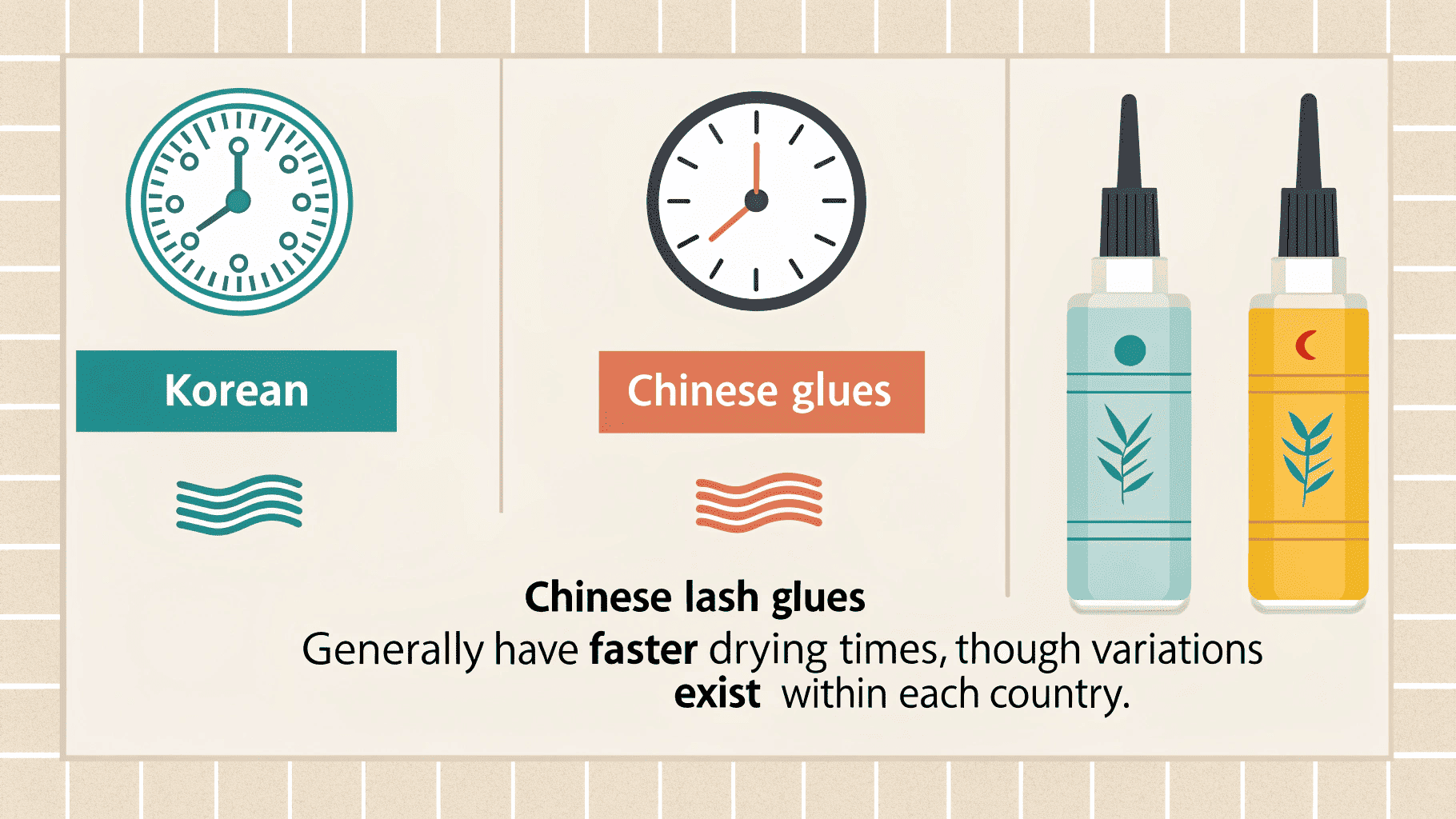
Dive Deeper: Drying Time Considerations
- Fast Drying (0.5-1 second): Preferred by experienced lash artists who work quickly. More common in Chinese glues.
- Medium Drying (1-2 seconds): A versatile option for many lash artists.
- Slow Drying (3+ seconds): Better for beginners or those working in humid environments. More common in Korean glues marketed for sensitive eyes.
Your ideal drying time depends on your skill level, technique, and the humidity of your workspace. It is important for you to choose the lash extension glue based on your work speed4
| Drying Time | Ideal For |
|---|---|
| 0.5-1 second | Experienced lash artists, low humidity. |
| 1-2 seconds | Versatile, suitable for many lash artists. |
| 3+ seconds | Beginners, high humidity, or sensitive clients. |
Conclusion
Choosing between Korean and Chinese lash adhesives ultimately depends on your specific needs and preferences. Both countries offer high-quality options, but Chinese manufacturers like UBLash often provide faster drying times, lower MOQs, and greater customization options, making them particularly attractive for lash businesses of all sizes. 2
-
Exploring best practices can enhance your skills and ensure a safe, effective lash extension process. ↩ ↩ ↩
-
Understanding the essential skills of lash technicians can help you choose the right professional for your needs. ↩ ↩
-
Discovering the advantages of customized glues can lead to better results and client satisfaction in lash extensions. ↩
-
Choosing the best lash extension glue depends on several factors, including your work speed, the technique you use, and your client’s needs ↩

Fanny
Lash Technician
Hi, I’m Fanny, the author of this post.
Over the past 5 years, we have assisted numerous lash salons and technicians across 20 countries to build their lash brand and grow their businesses with high-quality lash extension products.
If you have any questions or need assistance, feel free to reach out for a free consultation or to discuss tailored solutions for your business needs.
More Interesting Posts
Bulk Lash Extension Purchasing: MOQ Negotiation & Volume Discounts
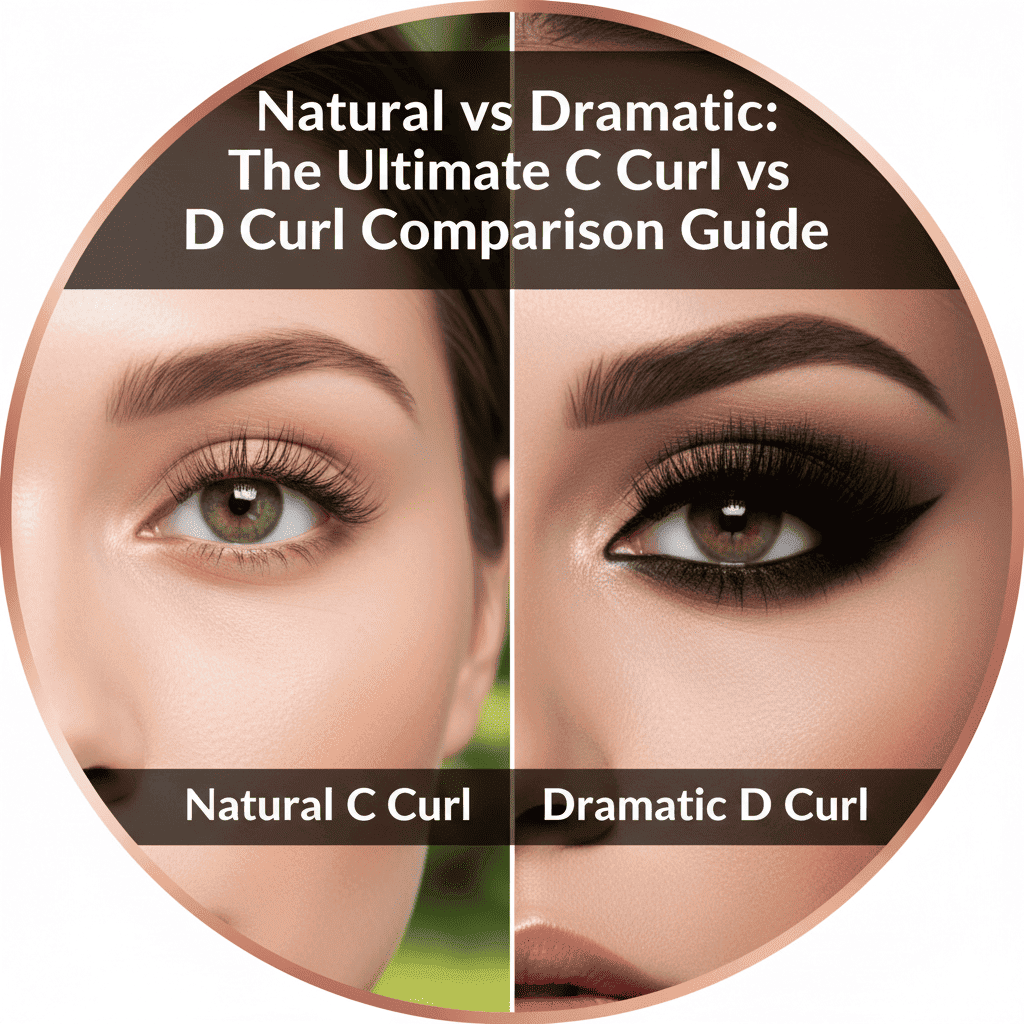
Natural vs Dramatic: The Ultimate C Curl vs D Curl Comparison Guide

B Curl vs C Curl vs D Curl: Which Eyelash Extension Curl is Right for Your Eye Shape?
